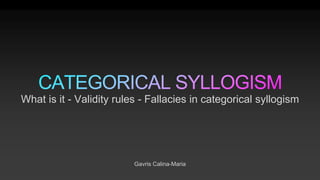
Critical thinking categorical syllogism pptx
- 1. Gavris Calina-Maria What is it - Validity rules - Fallacies in categorical syllogism
- 2. What is it? A syllogism is a deductive argument consisting of two premises and one conclusion. A categorical syllogism is a syllogism that is composed entirely of categorical propositions that is capable of being translated into standard form. Example: All primates are mammals. All humans are primates. Therefore, all humans are mammals.
- 3. The major term is the predicate of the conclusion. The minor term is the subject of the conclusion. The middle term, which provides the middle ground between the two premises, is the one that occurs once in each premise and does not occur in the conclusion. All primates are mammals. All humans are primates. Therefore, all humans are mammals. The major term in this example is “mammals," the minor term is "humans," and the middle term is "primates.” All valid categorical syllogisms such as this one have exactly three terms, each used exactly twice.
- 4. • A term is said to be distributed when it refers to all members of the class in question; it is undistributed when it refers to just some members. • The quantification of terms (whether a term refers to some or all members of a class) is one essential aspect of the formal validity of categorical syllogisms. Dogs have fleas. Rex is a dog. Therefore, Rex has fleas. The validity of this syllogism depends on the distribution of its terms: If “dogs” is distributed —> VALID. If “dogs” is undistributed —> UNVALID.
- 5. FIVE RULES FOR TESTING THE VALIDITY OF C.S 1. The syllogism must have 3 terms each used in the same sense. 2. The middle term must be distributed in at least one premise. 3. Whatever term is distributed in the conclusion must also be distributed in the premise in which it appears. 4. Between the major premise. There must be either no negative statements or exactly two, one of which is the conclusion. 5. The syllogism cannot have a particular conclusion and two universal premises unless the minor premise has existential import.
- 6. Fallacies in categorical syllogism • The four terms fallacy: violates the first rule (3 terms 1 sense). Therefore, this involves using the same term in two different senses. Example: All pigs have tails. All fascists are pigs. So, all fascists have tails. The word “pig” is used in two different senses. In one sense, that in which the term is used in the minor premise, “pig” refers to a gross person. In the sense of the term employed in the major premise, “pig” refers to the farm animal.
- 7. • Fallacy of Undistributed Middle Term: violates rule 2, which requires that the middle term has to be distributed in at least one of the premises. Example: Some mammals are cows. All humans are mammals. So, some humans are cows. The middle term is “mammals,” which is undistributed in both premises and only refers to some mammals. The major premise refers to cows, which are mammals, and the minor premise refers to humans, which are also mammals. But, the conclusion is invalid because the middle term in each of its occurrences refers to distinct classes of mammals but not to all mammals. For example, the syllogism would be valid if the major premise said that all mammals are cows.
- 8. • Fallacy of Illicit Distribution: violates rule 3, which requires that whatever term is distributed in the conclusion has to be distributed in the premise. Example: All monkeys are primates. No humans are monkeys. So, no humans are primates. The major term “primates” is distributed in the conclusion but not in the major premise. This means that the conclusion is saying something about all primates while the major premise is saying something about only some primates. If all humans are excluded from the class of monkeys does not mean that they must be excluded from the class of all primates. The conclusion of this syllogism is therefore invalid.
- 9. • Faulty Negative Fallacy: violates rule 4, which states that in a valid syllogism, as between its major/minor premise and conclusion, there can be either no statements with negative quality or exactly two, one of which must be in the conclusion. Example: No males are females. No women are males. So, no women are females. Just because women are excluded from males, and males from females, it does not follow that women are excluded from females.
- 10. • Existential Fallacy: violates rule 5. It’s an invalid inference from premisses which are not existential to a conclusion which is existential. An existential proposition is one which asserts or implies existence. Example: No pets are mythical creatures. All centaurs are mythical creatures. So, some centaurs are not pets. The minor premise talks about “centaurs”, which is obviously an empty class. Therefore, the conclusion “Some centaurs are not pets” cannot be valid because it implies the existence of centaurs, meanwhile the minor premise does not.